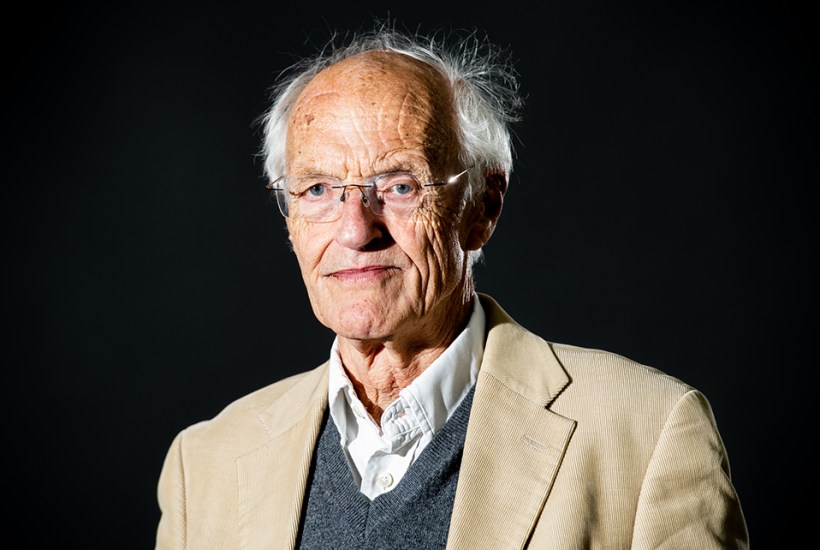Tell me who you go with, and I’ll tell you who you are. Guided by this principle, Michael Frayn devotes his new memoir to his friends, embracing the chance to pay tribute to those who shaped him. The octogenarian warns in the foreword that his choice of protagonists is ‘pretty capricious’ – a comment on the arbitrary nature of both memory and creativity – and yet the way he treats them is anything but fickle. He remembers every one of them with fondness, never slipping into sentimentality or idealisation.
These sober recollections are interlaced with the irony familiar from Frayn’s novels, while his playwright’s genius occasionally flashes in such lines as ‘Two legs – a very reasonable number’. Every encounter is described in a self-effacing manner – ‘he mostly talking, me mostly listening’ being a common scenario. It’s only at the end that Frayn turns to his own persona, or rather his physical self. The final chapter ‘begins, like the story of man in the Bible, with a fall’ – on the night when Frayn collapsed in his bathroom, ‘as abruptly as democracy in a military putsch’ – and takes us on a tour of his body, from the feet to the brain, where memories are kept, processed and often lost.
Luckily, many of them survive. The memoir begins in 1955, in Cambridge, where Frayn read philosophy. Realising that he was privileged to be there made him feel fortunate, whereas another grammar school boy propelled upwards, Alan Bennett, didn’t enjoy this kind of social mobility. As he rereads (but, alas, doesn’t quote from) Bennett’s letters from Oxford, full of ‘savagely funny ridicule of my social aspirations’, Frayn ponders the question of class division. Returning to it throughout the book, he invites us to rise above stereo-typing. Neal Ascherson, for instance, is praised for his unexpected ‘profound unposhness’, and his concern for others, which Frayn experienced first-hand when they worked at the Manchester Guardian, as it was still called. Here, too, Frayn takes a back seat to talk about Ascherson’s journalistic talents, including his ‘serious empathy with the oppressed and struggling’.
There are relatively few women in the book, a fact that Frayn blames on the male-dominated world of his youth and on his aversion to the kiss-and-tell genre, a potential road to betrayal. He does, however, make an exception. When he met Liza Mrosovsky in 1957, it was ‘mutual thunderclap’ at first sight. Her letters – returning to them now, Frayn recognises the woman he loved but not her correspondent, ‘this irresolute, egotistic, but otherwise apparently wonderful phantom’ – preserve fragments of their affair, recounted here with great delicacy and warmth. Before doing so, Frayn tried to find Liza, but it was too late. On learning of her death, he sent the letters to her husband and got the family’s permission to quote from them.
It’s not just his closest confidants whose privacy Frayn is at pains to protect. ‘The past, it suddenly struck me, was not a fiction,’ he writes of the time when he thought of basing a character on a childhood friend. After some deliberation, he went ahead with the idea, still not knowing where it would lead him. Then, in a surprising turn, the long-lost friend resurfaced, giving Frayn the chance to run the manuscript of Spies past him before publishing the novel in 2002.
One particularly colourful story is dedicated to Elizabeth Hill, who ran the Joint Service School for Linguists, where Frayn learned Russian. She was ‘as unpredicted and unpredictable as the inspector general’, a demanding and encouraging teacher. Perhaps it was her bravura performances in the classroom that made Frayn fall in love with Russian literature, going on to translate Chekhov and Tolstoy. The school’s curriculum went beyond the classics; its purpose was to train spies, although Among Others is tight-lipped on the subject. The closest it gets to espionage is in a sketch about John Sackur, a Cambridge contemporary, who concealed his MI6 links from Frayn, thus embarrassing him in front of Harold Evans, the editor of the Sunday Times. Nevertheless, Frayn is grateful to the spy who duped him since ‘it was falling for yet another of his deceits that gave me the idea for one of mine’, the play Donkeys’ Years (1976). Sackur became the prototype for one of its characters, who is a doddle to cast ‘because, after all the anticipation, he fails to appear’.
Memoirs are often written to settle old scores; this one, by contrast, is about settling old debts. Remembering those who made him what he is, Frayn always finds things to applaud: their breadth of knowledge and sense of humour, their talent and imagination, their generosity of spirit and loyalty to friends. As his admirers know, he possesses all these qualities himself, but it’s the last two that really shine here, illuminating his unpretentious reflections on the past informed by the maxim: ‘What was, was.’
Got something to add? Join the discussion and comment below.
Get 10 issues for just $10
Subscribe to The Spectator Australia today for the next 10 magazine issues, plus full online access, for just $10.
You might disagree with half of it, but you’ll enjoy reading all of it. Try your first month for free, then just $2 a week for the remainder of your first year.








Comments
Don't miss out
Join the conversation with other Spectator Australia readers. Subscribe to leave a comment.
SUBSCRIBEAlready a subscriber? Log in